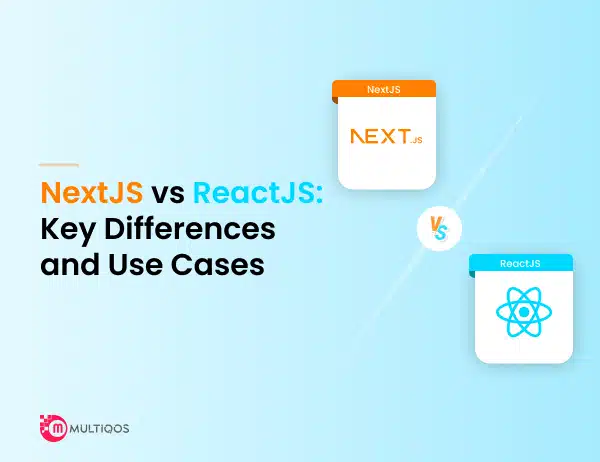Next JS vs React: Choosing the Best Front-End Framework in 2025

Table of Contents:
- Introduction
- What is React?
- What is Next.js?
- React vs. Next.js
- Performance Comparison
- Development Experience
- Flexibility & Scalability
- Use Cases & Best Scenarios
- SEO & Marketing Benefits
- Cost & Resource Implications
- Future-Proofing Your Projects
- Security Considerations
- Case Studies & Industry Examples
- Pros & Cons Summary
- Conclusion
- FAQs
Front-end development has demonstrated constant growth and progress with shifting into the year 2025. As new technologies and frameworks are constantly appearing on the market, developers have to follow the trends and decide what tools are the best for their work. The proliferation of web frameworks has led to the emergence of two widely adopted options for developers, React and NextJS.
According to the 2023 Stack Overflow Developer Survey, React is the second most popular web framework, used by 40.58% of professional developers. And Next JS is in the top 6 spot with 16.67% popularity amongst the developers.
Both are very effective in their own way but they exist at different levels to address different needs. So let’s look at this article as a brief comparison of React JS and Next JS, as well as their main benefits and appropriate application.
What is React?
React is an open-source frontend development library that was developed by Facebook and was released to the public back in 2013. It completely changed the paradigms of how one constructs user interfaces with its component-based approach. Since its inception, ReactJS development has gained a lot of traction and has an extensive and engaged community to its ecosystem.
Key Features of React
- Component-Based Architecture: React JS developers create reusable components that have their state and can be interconnected to build interfaces.
- Virtual DOM: React uses virtual DOM for changes in order to update the DOM more effectively and efficiently.
- Unidirectional Data Flow: It implements only one-way data binding that simplifies management of the data flow and results in an easier debug session.
- JSX Syntax: A few examples of additional syntax are jQuery, which is a library to JavaScript and JSX, which is incorporation of HTML style tags into JavaScript.
Use Cases of React
React is widely used for building single-page applications (SPAs), dynamic web applications, and mobile application development through React Native. It’s a great choice for projects that require a high level of interactivity and a seamless user experience.
What is Next JS?
It is primarily used for single page applications (SPA) development, dynamic web application development, and mobile app development using its flagship, React Native. As a result, it is particularly suitable for projects that evidence a high degree of interactivity and smooth usability.
Key Features of Next JS
- Server-Side Rendering (SSR): Next JS has features that allow the rendering of the pages on the server side before sending to the client side and this enhances SEO.
- Static Site Generation (SSG): Next JS provides features to generate static HTML pages during build time which tend to be faster and more scalable.
- API Routes: Next JS gives developers the flexibility of building the APIs as components of the overall application architecture.
- File-Based Routing: Next JS presupposes the file-based routing approach, which means the developers do not need to configure the routes separately.
Use Cases of Next JS
Next JS is best suited for any application where speed, search engine optimization, and extensibility are required. It is often used for simple webshops, blogs, websites for marketing campaigns, and any application where server-side rendering and static site generation come in handy.
Core Differences Between React and Next JS
Framework vs. Library
React is a JavaScript library mainly for rendering a user interface while Next. Next JS is an extension of React since it possesses extra functionalities such as SSR and SSG. Essentially, Next JS better fits for some situations, extending the functionality of React.
Server-Side Rendering (SSR) Capabilities
Even though React has the ability to integrate with SSR with the help of extra libraries and settings, Next JS has native support for SSR, compared to which the implementation of SSR in other frameworks and libraries can be quite fiddly.
Static Site Generation (SSG) Capabilities
Next JS is at its strongest at the static site generation, supporting developers to create static pages during the build process. While React, for instance, lacks similar functionality and one has to use external tools like Gatsby to achieve comparable performance.
Client-Side Rendering (CSR)
React primarily works in the client-side rendering principle where the browser directly renders the pages once the JS is downloaded. Next JS supports client-side rendering as well but it also comes with the advantage of server-side and static generation for increased speed and ranking.
Performance Comparison
Load Times
SSR and SSG help Next JS in having a generally better initial load time offer compared to plain React. By making pages on the server or producing static HTML the amount of JavaScript which needs to be run on the client side is minimized.
SEO Benefits
The features like server rendered pages and static contents are easily indexable by search engine bots and Next JS effectively boosts up the SEO performance. For instance, compared to React, React requires additional configurations and tools to attain similar abilities in SEO.
Speed and Efficiency
Next JS can also prerender pages and get static content out very fast; therefore, the tool is useful for websites with a high traffic rate. The optimizations apply to render the React library more efficient even when it comes to client-side rendering.
Development Experience
Ease of Learning
As compared to other JS frameworks, the learning curve is relatively low due to React’s simplicity and its focus on UI components. Next JS is also easy to get acquainted with, however, it is necessary to know several more features, such as SSR and SSG.
Community and Ecosystem
This is a flexible framework and it has a large community and a vibrant ecosystem with many libraries, tools, and resources. Next JS also has a rich community, and the sphere is progressing day by day with the help of the React framework.
Documentation and Support
While choosing between React and Next JS, it is possible to note that both have extensive documentation and strongly developed communities in the form of forums, social networks, as well as official discourse. This will make it easier to hire dedicated developers as per your requirements.
Flexibility and Scalability
Customization Options
Probably, one of the biggest assets of React is the flexibility it offers and its compatibility with a great number of libraries and tools to enable the creation of unique solutions. Despite having numerous features out of the box, with Next JS, it is possible to make as many customizations to a project as necessary.
Scalability for Large Projects
While both React and Next JS are scalable, Next JS is more appropriate for larger applications due to its server-side rendering and static site generation capabilities.
Integration with Other Tools and Technologies
The React ecosystem is rich and it lets you seamlessly connect with numerous components, frameworks, instruments, utilities, and services. Another framework built on React is Next JS, which also shares the capability of easy integration and can therefore be applicable in different projects.
Use Cases and Best Scenarios
When to Use React?
React is a great choice for:
- Single-page applications (SPAs)
- Projects requiring dynamic and interactive user interfaces
- Mobile applications (using React Native)
- Developers looking for a lightweight library to build custom solutions
When to Use Next JS?
Next JS is ideal for:
- E-commerce sites
- Blogs and content-driven websites
- Marketing websites requiring excellent SEO
- Projects needing server-side rendering or static site generation
Real-World Examples
- React: Facebook, Instagram, WhatsApp
- Next JS: Vercel, Hulu, TikTok
SEO and Marketing Benefits
How React Impacts SEO
React does not come with built-in support for SEO as it is primarily a client-side framework, and additional tools such as Next JS or Gatsby are needed for that. Without these optimizations, the React applications may experience some challenges of being indexed by the search engines.
How Next JS Enhances SEO
Next JS does well in SEO since it automatically generates server side rendered pages alongside offering the ability of static content. Metadata also helps to underpin the possibility of an easy crawl and indexing by search engine optimization which raises the visibility and the rank.
Marketing Considerations
Marketing websites can benefit from the SEO capabilities integrated into Next JS out of the box. The faster loading and increased performance also become beneficial for users, which may lead to better sales rates and better interaction.
Cost and Resource Implications
Development Costs
Due to its attribute of being a library, React facilitates a flexible and affordable manner to work in. While Next JS could be more expensive at the start since it comes equipped with additional functionalities, the improved speed and SEl optimization make it all worth it.
Maintenance and Upkeep
Both React and Next JS are pretty stable but need updates regularly to stay with the latest version and changes. Nex JS might need more focus because of its server-side and static generation capabilities, however, as a result, it has more in-built optimisations.
Resource Availability
React has better developers and more resources available, simply because it is extensively used in the industry. Next JS is relatively new, as a result, the companies using it are also fewer, which might mean that there will be fewer developers with experience in Next JS.
Future-Proofing Your Projects
Trends in Front-End Development
The increasing popularity of static site generation, server-side rendering, and better SEO will remain significant in the future, which will greatly contribute to the Next JS framework. React will also be in demand because of its openness and popularity of the ecosystem.
Long-Term Support and Updates
In terms of their maintenance, React and Next JS are both very active and well updated. Given that React has a bigger community, one could say that it has faster updates and more third-party support. Next JS is also privileged to use Vercel’s support and has frequent updates in its features.
Community and Industry Adoption
Due to the extensive usage of React, it has a strong community support base and it remains active. To extend the possibilities of React, Next JS has rapidly emerged as a popular choice among developers focusing on performance and SEO.
Security Considerations
Security Features in React
React provides access to some security features, but to protect against common risks such as XSS attacks, developers have to follow some guidelines. It is very important to use libraries and tools that provide the filtering of security standards.
Security Enhancements in Next JS
There are still enhanced security features that Next JS offers which are for server-side rendering and API routes. As a result, Next JS communicates with more on the server side, it can provide a stronger safeguard against certain types of cyberattacks.
Best Practices
As with any form of coding, for both React and Next JS, the best practices should always be followed such as data entry sanitation, data validation, and updating the dependencies frequently.
Case Studies and Industry Examples
Popular Companies Using React
- Facebook: The origin of React, used extensively across its products.
- Instagram: Another Facebook product leveraging React for dynamic user interfaces.
- WhatsApp: Uses React to provide a seamless messaging experience.
Popular Companies Using Next JS
- Vercel: The creators of Next JS use it for their own website and applications.
- Hulu: Uses Next JS to deliver high-performance streaming experiences.
- TikTok: Leverages Next JS for its web platform to enhance performance and SEO.
Lessons Learned from Case Studies
These companies show how React along with Next JS excel when it comes to Real Business Applications which are not just large-scale and extremely performance-critical. It is often up to the project’s requirements such as the need for SEO, execution speed or even the extent of the user interface needed.
Pros and Cons Summary
Pros and Cons of React
- Pros:
- Lightweight and flexible
- Extensive ecosystem and community support
- Ideal for dynamic, interactive UIs
- Cons:
- Requires additional tools for SSR and SEO
- Can lead to larger bundles if not optimized
Pros and Cons of Next JS
- Pros:
- Built-in SSR and SSG for better performance and SEO
- Easy to set up and start
- File-based routing and API routes simplify development
- Cons:
- Slightly steeper learning curve due to additional features
- Higher initial development costs
Conclusion
It is important to note that both React and its successor Next JS exist as viable options of front-end development in 2025 depending on project characteristics. React would be helpful if you require a component-based architecture for creating complex and responsive UIs. That said, if your project requires server-side rendering, static site generation, sophisticated SEO, Next JS will be your cup of tea. Both are indispensable and can handle anything, so you will be capable of creating top-notch applications regardless of the tool selected.
FAQ on NextJS vs React in 2025
MultiQoS specializes in optimizing the performance of existing applications by leveraging the capabilities of React and Next.js. We conduct thorough performance audits, implement server-side rendering (SSR) and static site generation (SSG), and optimize code to ensure faster load times and improved user experiences.
Choosing MultiQoS means partnering with a team of skilled developers with extensive experience in React and Next.js. We offer customized solutions, a client-centric approach, and a commitment to delivering high-performance, SEO-friendly applications that meet your unique business requirements.
Starting a project with MultiQoS is simple. Contact us through our website, schedule a consultation to discuss your project requirements, and our team will create a tailored development plan. We’ll work closely with you throughout the project to ensure your vision is realized effectively.
Yes, MultiQoS is equipped to handle large-scale projects and provides ongoing maintenance services. Our team ensures your application remains up-to-date with the latest features, security updates, and performance optimizations, allowing your business to scale seamlessly and maintain a competitive edge.
Get In Touch








